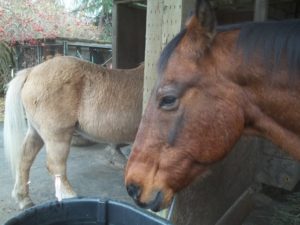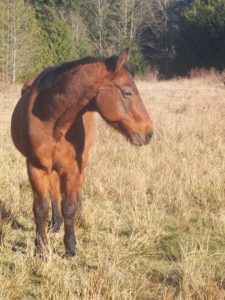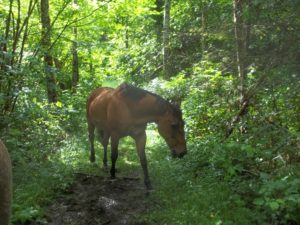Having spent years learning to ride and then learning to train horses, all of the focus was on training the horse to do what I asked. I learned a lot about horses and how to train them and how to ride them, however, I didn’t really know them.
When I took in my first senior horse to rehab several years ago, my focus was different. It was no longer about me, but rather about the horse and what could I do to help facilitate bringing him back to full health. The only question I asked of the horse was, “What can I do to help you be fully alive?”
What I have learned over the past several years rehabbing senior horses is that every moment of every day horses are speaking through their body language. Much of it we miss and don’t understand.
Just the other day I went out to see my horse, Chaco. I missed him, and as much as I wanted to go up to him and give him a big hug, I held back and simply took a meandering walk in his direction to see if he was okay with me approaching him.
He was standing, taking a nap, and I stopped and waited several feet away from him. Eventually I slowly approached his shoulder. He seemed okay if I put my hand on his shoulder, and he would close his eyes in certain places where I placed my hand, but the look in his eye alternated between going to sleep and being fixed.
I searched for how could I touch where his ears did not go back in the slightest way and where his eyes started to close. It was a tricky dance to dance that day. I couldn’t quite find the perfect spot for very long. I really wanted to give him a hug, but because I was having difficulty finding just the right spot to place my hands, I knew he was already tolerating me touching him, and a hug was not what he wanted.
So I took a step back and went around to the front of him. When I stood there looking at him his expression and eyes and ears were softer and more accepting so I stayed there.
Looking at him, I asked out loud, “How can I help you?”
I had no answer myself, and I wondered if he felt o.k. I just watched him and his body language, hopeful that he might enlighten me.
After a few minutes of me breathing, relaxing and just observing him while I asked that question, he eventually turned his head 90 degrees to his left and looked at the field on the other side of the fence.
I had seen that look in his eyes before. (It was when we took a walk down the road and he just meandered to a stop at a neighboring driveway, turned his head 90 degrees and looked down the driveway and then back at me. I knew there was a grass patch at the end of that driveway that he liked to graze, so we took a detour to the grass patch, and I let him graze).
So standing in the field with him this particular day and seeing that familiar look in his eyes, I took a chance and took off his halter, grabbed the grooming bucket I had brought out with me and walked over to the gate while telling him, “Come on, Chaco, let’s get out of here and you can have some goodies (i.e., the green grass).”
“Would he come with me?” I wondered to myself.
Since the gate was only 25 feet away, it didn’t take me long to get there, but knowing that a horse’s resting heart rate is half the rate of a human’s, I knew it might take him several minutes to stroll over to the gate. I also still wasn’t even sure he was asking me to let him out.
Sure enough though, not far behind me, he came. Of course, his pasture mate perked up when she saw that he was going to get out.
In my mind I’m thinking, “Come on, Chaco, let’s go before she gets up here.”
Chaco almost picked up a trot, got to the gate, and I was just able to close it in time so only he got out.
We proceeded to have a lovely afternoon. He grazed for a few minutes, and then we went for a walk down the road and brought his pasture mate along. He moved out well, navigated a tight spot through the trees and bushes on a trail and found some sword ferns to nibble on in the process.
All of this happened because I refrained from hugging him, and instead stopped and observed him to try and figure out what he wanted.
The glare in his eyes and the ears slightly back were a “no” to my hands touching him. The 90 degree turn of his head to the left in the direction of the neighboring pasture was a request.


When we slow down and take time to register every little movement a horse makes and ask ourselves what that might mean, we start to discover that they are communicating all the time.
I’m sure I’m just on the tip of the iceberg of what he is communicating to me. The more I listen, the more he teaches me the body language of horses, and the more I discover who he is. For me, that is why I rehab senior horses.

